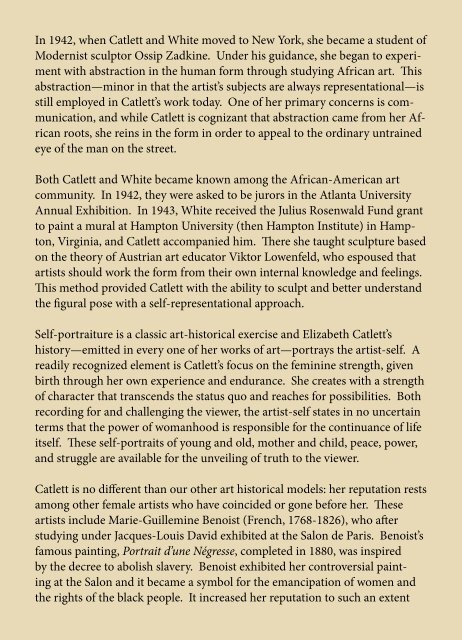The Art Of Elizabeth Catlett Sculptures And Prints
The Art Of Elizabeth Catlett Sculptures And Prints
The Art Of Elizabeth Catlett Sculptures And Prints
Create successful ePaper yourself
Turn your PDF publications into a flip-book with our unique Google optimized e-Paper software.
In 1942, when <strong>Catlett</strong> and White moved to New York, she became a student of<br />
Modernist sculptor Ossip Zadkine. Under his guidance, she began to experiment<br />
with abstraction in the human form through studying African art. This<br />
abstraction—minor in that the artist’s subjects are always representational—is<br />
still employed in <strong>Catlett</strong>’s work today. One of her primary concerns is communication,<br />
and while <strong>Catlett</strong> is cognizant that abstraction came from her African<br />
roots, she reins in the form in order to appeal to the ordinary untrained<br />
eye of the man on the street.<br />
Both <strong>Catlett</strong> and White became known among the African-American art<br />
community. In 1942, they were asked to be jurors in the Atlanta University<br />
Annual Exhibition. In 1943, White received the Julius Rosenwald Fund grant<br />
to paint a mural at Hampton University (then Hampton Institute) in Hampton,<br />
Virginia, and <strong>Catlett</strong> accompanied him. <strong>The</strong>re she taught sculpture based<br />
on the theory of Austrian art educator Viktor Lowenfeld, who espoused that<br />
artists should work the form from their own internal knowledge and feelings.<br />
This method provided <strong>Catlett</strong> with the ability to sculpt and better understand<br />
the figural pose with a self-representational approach.<br />
Self-portraiture is a classic art-historical exercise and <strong>Elizabeth</strong> <strong>Catlett</strong>’s<br />
history—emitted in every one of her works of art—portrays the artist-self. A<br />
readily recognized element is <strong>Catlett</strong>’s focus on the feminine strength, given<br />
birth through her own experience and endurance. She creates with a strength<br />
of character that transcends the status quo and reaches for possibilities. Both<br />
recording for and challenging the viewer, the artist-self states in no uncertain<br />
terms that the power of womanhood is responsible for the continuance of life<br />
itself. <strong>The</strong>se self-portraits of young and old, mother and child, peace, power,<br />
and struggle are available for the unveiling of truth to the viewer.<br />
<strong>Catlett</strong> is no different than our other art historical models: her reputation rests<br />
among other female artists who have coincided or gone before her. <strong>The</strong>se<br />
artists include Marie-Guillemine Benoist (French, 1768-1826), who after<br />
studying under Jacques-Louis David exhibited at the Salon de Paris. Benoist’s<br />
famous painting, Portrait d’une Négresse, completed in 1880, was inspired<br />
by the decree to abolish slavery. Benoist exhibited her controversial painting<br />
at the Salon and it became a symbol for the emancipation of women and<br />
the rights of the black people. It increased her reputation to such an extent


